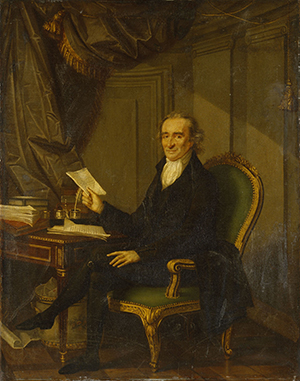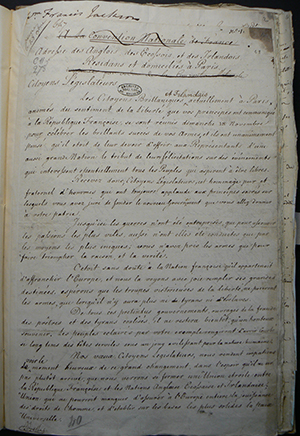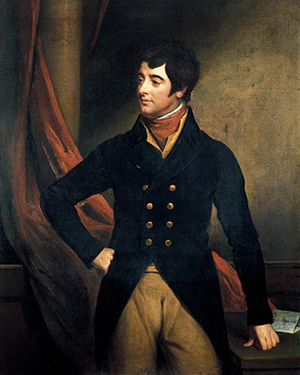‘Un festin patriotique’ at White’s Hotel, 18 November 1792: the ‘secret’ origins of Irish revolutionary republicanism
Published in 18th–19th - Century History, Features, Issue 3 (May/June 2016), Volume 24A BANQUET THAT TOOK PLACE IN PARIS IN NOVEMBER 1792, CONCEIVED AS BOTH A PUBLIC CELEBRATION AND AS A SECRET EVENT, SHEDS LIGHT ON THE LITTLE-KNOWN ORIGINS OF IRISH REPUBLICANISM AND ON THE REVOLUTIONARY IDEALS OF SOME OF THE (FUTURE) UNITED IRISHMEN
By Mathieu Ferradou
On 18 November 1792, about 100 guests or convives gathered at a dinner in White’s Hotel, near the Palais-Royal (then aptly renamed Palais-Egalité) in Paris, to celebrate the recent victories of the French army at Valmy and Jemappes against the Prussian and Austrian invaders. As the London Morning Chronicle reported on 26 November, this dinner was mainly attended by representatives from the English-speaking world—Englishmen, Scotsmen, Welshmen, Irishmen and Americans—but also by Italians, Prussians, Austrians, Dutch and some distinguished Frenchmen, making it a true gathering of the European revolutionary and republican galaxy.

Above: Thomas Paine, the English-born ‘founding father’ of the American Revolution and author of Rights of Man (1791 and 1792), was the guest of honour. (NPG)
Thomas Paine the guest of honour
The guest of honour was Thomas Paine, the English-born ‘founding father’ of the American Revolution and author of Rights of Man (1791 and 1792), a spirited defence of the French Revolution in response to Irish-born, British imperialist Edmund Burke’s Reflections on the Revolution of France (1790). Prosecuted for seditious libel in England, Paine had fled to France, where he had been elected in September 1792 to the National Convention, which had the task of writing a new constitution after the abolition of the monarchy and the advent of the republic.
In a series of rousing toasts, the list of which was published in several Parisian, London and Dublin newspapers, the guests, under the supervision of British radical John Hurford Stone as chairman, celebrated the ‘Republic of France, founded on the Rights of Man’; the ‘armies of France and their citizen-soldiers’; the ‘fall of tyrants and tyranny’; the ‘coming conventions of England and Ireland’; and the ‘perpetual union of all free peoples of England, France, America and Low Countries’. Other toasts, known as ‘healths’, were given to Lord Edward FitzGerald and to Sir Robert Smith (a former British MP), who both formally renounced their titles on this occasion, the former demanding to be addressed as ‘citoyen Edouard Fitzgerald’. Feminist writers Charlotte Smith, Helen Maria Williams and Laetitia Barbauld were also celebrated, as well as ‘patriot’ publicists like Joseph Priestley, John Horne Tooke, Joel Barlow and others. Many patriotic songs (Ça ira; La Marseillaise) punctuated the toasts, which ended with one to ‘universal peace, founded on universal liberty’.
About twenty Irishmen attended this dinner. Among them were, as noted, Lord Edward FitzGerald (who had accompanied Paine to Paris) and Henry and John Sheares, all three of whom would die just before or during the 1798 Rebellion. Other less well-known Irishmen were there: future MP for Wexford Caesar Colclough, journalists Robert O’Reilly and D.E. McDonnel, Anglican Revd William Jackson, ‘Wild Geese’ French generals Arthur Dillon and Thomas Ward, ex-priest Nicholas Madgett, Irish seminary students William Duckett, Bernard MacSheehy, Jeremie Curtayn, Edward Ferris, Bartholomew Murray and Jean O’Neill, and ex-colonel of Volunteers Thomas MacDermott.
Address to the National Convention
After the fourth toast someone, perhaps John Sheares (according to a future member of the group, Henry Redhead Yorke, who would later turn loyalist), proposed that the guests write an address of congratulations to the French National Convention, which was accepted by acclamation. On the following Saturday, 24 November, 50 of the guests (among whom were sixteen Irish) gathered again to sign the address, which had been composed by a committee of fifteen (headed by McDonnel and among whom were FitzGerald and the Sheares brothers), according to British spy Captain George Monro, who arrived a few days later. This address acknowledged the ‘French Nation’ as the liberator of the whole of Europe, and hoped ‘that the victorious troops of liberty will not depose their arms up until there are no more tyrants or slaves’. It was duly presented to the Convention on Wednesday 28 November by a delegation of twenty, who received a very warm welcome and were given the honours of the assembly.
All these events—the dinner, the drafting of the address and its subsequent presentation—were the birth of what British historian John Goldworth Alger would later improperly call the ‘British Club’ but whose members made themselves known officially (as the Parisian gazette, the Moniteur, records on 7 January 1793) as the Société des Amis des Droits de l’Homme (Society of the Friends of the Rights of Man or SADH), a reference both to the seminal declaration upon which the Revolution was founded and to Paine’s influence.

Above: First page of the ‘Adresse des Anglais, des Ecossais et des Irlandais résidans et domiciliés à Paris’ to the Convention, presented on 25 November 1792. The address was part of a dialogue between the Société des Amis des Droits de l’Homme (SADH) and the French government about the possibility of an insurrection in Britain and/or Ireland in late 1792. Though the early Irish republicans did not get their wish, notably because of the astute policy of Pitt’s cabinet, their political activism between Dublin, Belfast, London and Paris shows that Irish republicanism grew alongside its French counterpart. (Archives Nationales, Pierrefitte-sur-Seine)
From these elements, it is clear that Irishmen held a very important place in this patriotic society. The dinner and the address were the public display of their radical enthusiasm for the French Revolution. The society, however, also had more covert activities. Indeed, Paine, FitzGerald, the Sheares and Scottish poet and soldier John Oswald were actively plotting an armed insurrection in England and/or Ireland, and trying to force Jean-Jacques Brissot and the Girondins, at that time the leading group in the Convention, out of their declared policy of neutrality toward England. Their manoeuvres met with some success, as it is no coincidence that, the day after the dinner, the Convention, under the presidency of the Abbé Henri Grégoire, who had links with the SADH, passed the (in)famous decree of 19 November 1792 promising help and fraternity to all peoples who would rise up against their government to establish their liberty.
In so doing, the SADH hoped to be able to ‘revolutionise’ England and Ireland. Their greatest hope lay in Ireland, where they expected that the coming Catholic Convention in Dublin in December 1792, which had been a powerful vector of popular politicisation, would formulate demands that the British ministry would not accept. The anticipated refusal would induce discontent and spark a revolution spearheaded by the revived Volunteers, supported by French funds. In Dublin and Belfast, James Napper Tandy attempted to transform some Volunteer battalions into a ‘National Guard’ on the model of France, complete with green cockades, while several republican and Jacobin societies cropped up in Belfast. The Defenders’ agitation was on the rise, as they were evolving from a secret agrarian Catholic society into a more urban, middle-class, Jacobin movement, possibly under the influence of Parisian-trained priest James Coigly. FitzGerald travelled to London, ostensibly to obtain permission from his mother for his marriage, which took place on 27 December, with Pamela, the putative natural daughter of Duke Philippe ‘Egalité’ d’Orléans, cousin of former King Louis XVI, who had publicly endorsed the Revolution. He used this trip, however, to liaise with the delegates of the Catholic Convention in London, with the blessing of Charles-Frédéric Reinhard, secretary of the French ambassador. In London, French agent François Noël (possibly of Irish origin) met representatives of a shadowy ‘Irish Revolutionary Committee’, which sent to Paris an agent, Irish-born ex-priest Richard Ferris, to meet the minister for foreign affairs, Pierre Lebrun.
‘Pitt’s Terror’
The dinner, and the subsequent decree of 19 November, provoked consternation in Britain but also, between December 1792 and January 1793, a swift and decisive response to the threat of internal subversion and insurrection, a policy which has been called, with some exaggeration, ‘Pitt’s Terror’. FitzGerald was cashiered from the British army on 24 December despite Charles James Fox’s defence of his cousin. In addition, the British government repeatedly asked French ambassador François-Bernard de Chauvelin about the decree of 19 November and its possible application to Ireland. While Chauvelin tried to assuage Pitt’s fears, he did so without being himself convinced that France would not help the Irish against Britain. Preparing for war, Pitt obtained from parliament the passing of the Alien Act on 7 January after a tumultuous debate during which Edmund Burke dramatised the threat of a French-supported conspiracy in England, mentioning the SADH. The Alien Act specifically targeted French residents in Britain, who were then under constant surveillance and even the threat of arrest, a measure that provoked outrage in France and contributed to the rise of tensions between the two countries. Pitt also augmented the security forces in London (December) and, in Ireland, Dublin Castle secured the passing of the Gunpowder and Convention Acts (February), banning the import of firearms and forbidding gatherings that claimed a representative function. These measures were violently opposed by Edward FitzGerald in parliament, causing no small scandal, but to no avail. Several United Irishmen were arrested in January. Warned by Thomas Hussey, Irish chaplain at the Spanish embassy in London and a personal friend of Edmund Burke, against the revolutionary potential of refusing the demands of the Catholics, Pitt pursued a policy of conciliation towards Irish Catholics in order to secure their loyalty. The Catholic delegates were favourably received in London: they were able to present their petition to the king in January, and in February the Castle presented to parliament a Catholic Relief Bill, which was passed in April. At the same time, the Militia Act authorised Catholics to bear arms, so that they could enlist in a militia against the renewed threat of French invasion.

Above: ‘Citoyen Edouard Fitzgerald’, portrayed here by Hugh Hamilton Douglas in revolutionary fashion (red cravat, cropped hair, blue jacket), was one of the founding and leading members of the SADH, along with the Sheares brothers, Henry and John. (NGI)
Many United Irishmen revolutionary from the outset
As a result of all these astute measures, the expected or dreaded insurrection did not happen. The consequences, however, were no less important—citizenship in Ireland was opened. Perhaps even more importantly, it thus appears that, contrary to a chronology commonly accepted, it was not the war that prompted a rapprochement between the Irish and France but rather the links between Irish revolutionaries and French officials, as exemplified in the dinner at White’s Hotel, the address to the Convention and the decree of 19 November, which contributed to the rise of tensions between France and England, adding to their geopolitical and ideological rivalry. The execution of Louis XVI was, in this context, only the pretext that Britain needed to break off diplomatic relations with France, forcing the latter to declare war on 1 February 1793. This sequence also scotches the idea that Irish republicanism and revolutionary nationalism only came later as a result of the repression of the United Irishmen in 1794–5. It was an entry into revolutionary politics for a number of actors who would later play a pivotal role in the events leading up to the Bantry Bay expedition in 1796 and the expeditions of 1798, as well as the Despard conspiracy and Emmet’s insurrection of 1803. When Theobald Wolfe Tone would arrive in France in February 1796, he would meet and be guided by Irish patriots like Nicholas Madgett and William Duckett, who were members of the SADH and who tirelessly worked for the independence of Ireland under all subsequent revolutionary governments. Granted, the Irish who were present at White’s were not among the founding members of the society, but their non-sectarian, precocious and revolutionary republicanism, as well as their multiple networks of contacts, from French officials to Defenders and other shadowy organisations, show that, from the very beginning of the political agitation in Ireland, republicanism involved Catholics as well as Protestants, and that Irish republicanism and French republicanism grew together from the very start in 1792.
Mathieu Ferradou is a Ph.D candidate at the Institut d’Histoire de la Révolution Française (IHRF) and Institute d’Histoire Moderne et Contemporaine (IHMC), at the University of Paris 1 Panthéon Sorbonne, and a high school teacher of history and geography in France.
FURTHER READING
M. Elliott, Partners in revolution: the United Irishmen and France (New Haven & London, 1982).
D.V. Erdman, Commerce des Lumières. John Oswald and the British in Paris, 1790–1793 (Columbia, 1986).
H. Gough & D. Dickson (eds), Ireland and the French Revolution (Dublin, 1990).
D. Keogh, The French Disease: the Catholic Church and radicalism in Ireland in the 1790s (Dublin, 1993).
















